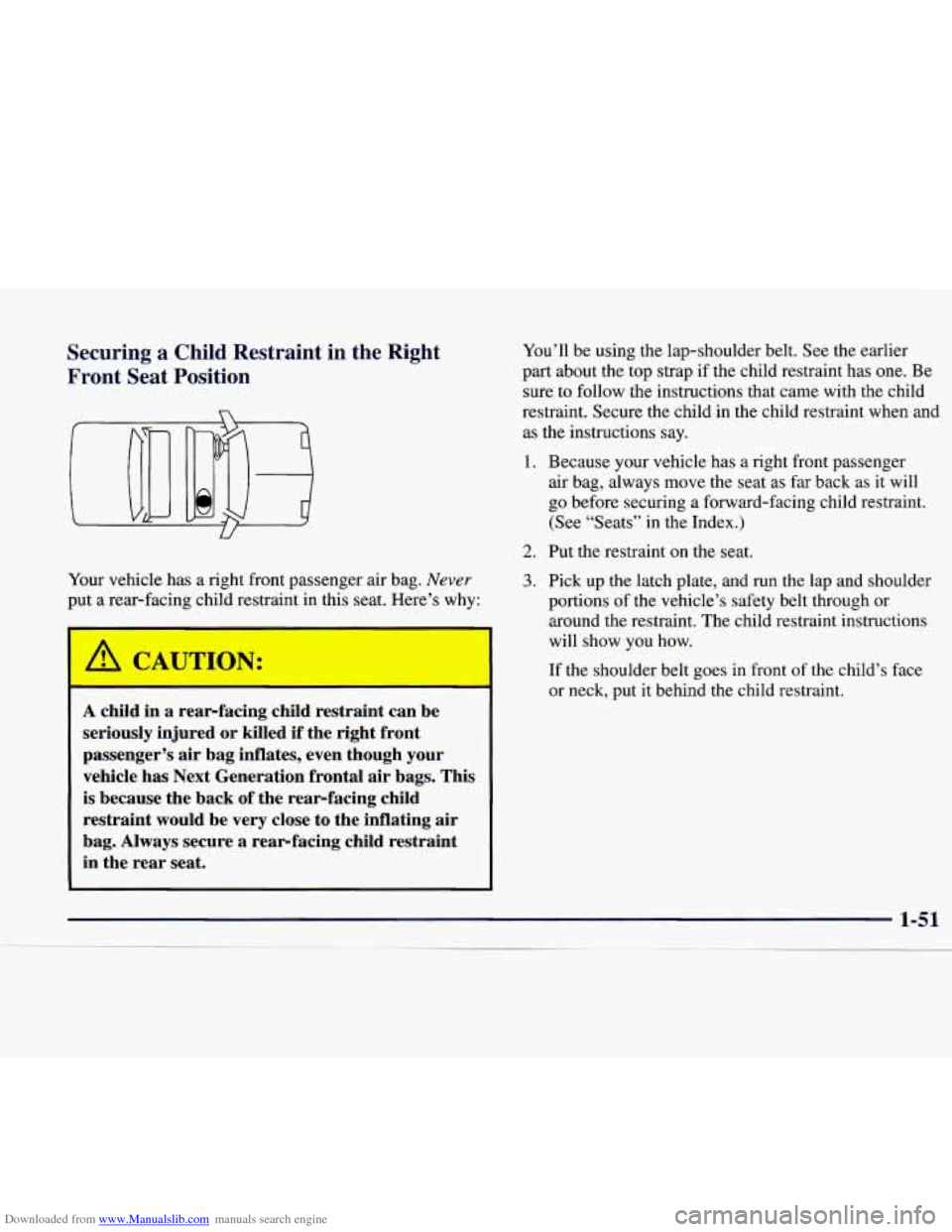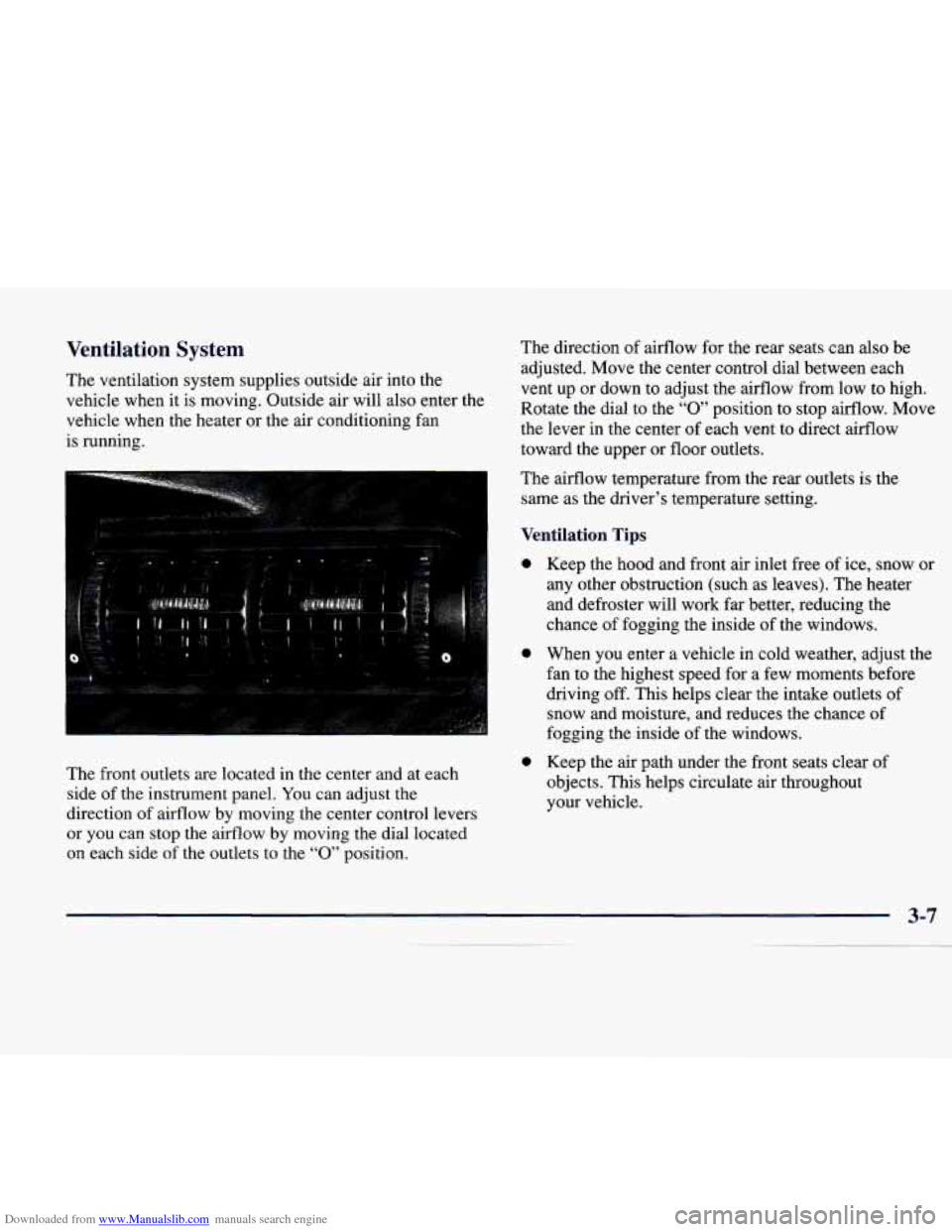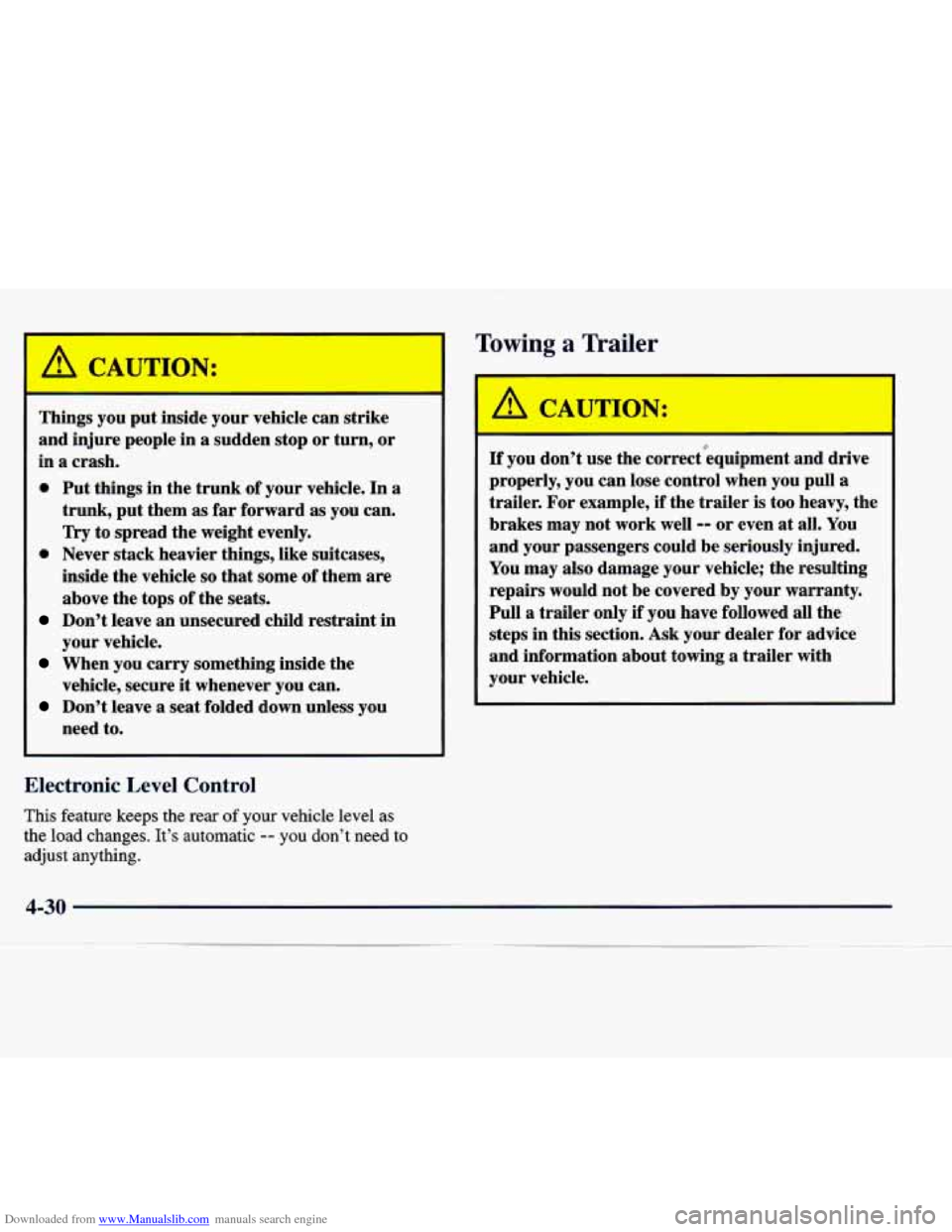Page 27 of 346

Downloaded from www.Manualslib.com manuals search engine It is extremely dangerous to ride in a cargo area,
inside or outside of
a vehicle. In a collision,
people riding in these areas are more likely to be
seriously injured
or killed. Do not allow people to
ride in any area of your vehicle that is not
equipped with seats and safety belts. Be sure
everyone in your vehicle is in
a seat and using a
safety belt properly.
Your Catera has a light
that comes on as
a reminder
to buckle
up. (See “Safety
Belt Reminder Light” in
the Index.)
In most states and Canadian provinces, the law says to
wear safety belts. Here’s why:
They work.
You never know if you’ll be in a crash. If you do have
a crash, you don’t know if it will be a bad one.
A few crashes are mild, and some crashes can be so
serious that even buckled up a person wouldn’t survive.
But most crashes are in between.
In many of them,
people who buckle
up can survive and sometimes
walk away. Without belts they could have been badly
hurt or killed.
After more than
30 years of safety belts in vehicles,
the facts are clear. In most crashes buckling up does
matter
... a lot!
Page 32 of 346

Downloaded from www.Manualslib.com manuals search engine How to Wear Safety Belts Properly
Adults
This part is only for people of adult size.
Be aware that there are special things to know about
safety belts and children. And there
are different
rules for smaller children and babies.
If a child will
be riding in your vehicle, see the part
of this
manual called “Children.” Follow those rules for
everyone’s protection.
First, you’ll want to know which restraint systems
your vehicle has.
We’ll start with the driver position.
Driver Position
This part describes the driver’s restraint system.
Lap-Shoulder Belt
The driver has a lap-shoulder belt. Here’s how to wear
it properly.
1. Close and lock the door.
2. Adjust the seat (to see how, see “Seats” in the Index)
so you can sit up straight.
A
3.
4.
Pick up the latch plate and pull the belt across you.
Don’t let it get twisted.
The shoulder belt may lock if you pull the belt across
you very quickly. If this happens, let the belt
go back
slightly to unlock it. Then pull the belt across you
more slowly.
Push the latch plate into the buckle until it clicks.
1-19
Page 57 of 346
Downloaded from www.Manualslib.com manuals search engine A rear-facing infant restraint (B) positions an infant
to face the rear
of the vehicle. Rear-facing infant
restraints are designed for infants of up to about
20 lbs. (9 kg) and about one year of age. This type
of restraint faces the rear
so that the infant’s head,
neck and body can have the support they need in a
crash. Some infant seats come in two parts
-- the
base stays secured in the vehicle and the seat part
is removable.
1-44
Page 59 of 346
Downloaded from www.Manualslib.com manuals search engine A booster seat (F, G) is designed for children
who are about
40 to 60 lbs. (1 8 to 27 kg) and
about four to eight years
of age. It’s designed to
improve the fit of the vehicle’s safety belt system.
Booster seats with shields use lap-only belts;
however, booster seats without shields use lap-shoulder belts. Booster seats can also help
a child to see out the window.
Page 64 of 346

Downloaded from www.Manualslib.com manuals search engine Securing a Child Restraint in the Right
Front Seat Position You’ll be using the lap-shoulder belt. See the earlier
part about the top strap if the child restraint has one.
Be
sure to follow the instructions that came with the child
restraint. Secure the child in the child restraint when and
as the instructions say.
1.
Your vehicle has a right front passenger air bag. Never
put a rear-facing child restraint in this seat. Here’s why:
2.
3.
I
A child in a rear-facing child restraint can be
seriously injured or killed if the right front
passenger’s air bag inflates, even though your
vehicle has Next Generation frontal air bags. This
is because the back of the rear-facing child
restraint would be very close to the inflating air
bag. Always secure
a rear-facing child restraint
in the rear seat.
Because your vehicle has a right front passenger
air bag, always move the seat as far back as it will
go before securing a forward-facing child restraint.
(See “Seats” in the Index.)
Put the restraint on the seat.
Pick up the latch plate, and run the lap and shoulder
portions
of the vehicle’s safety belt through or
around the restraint. The child restraint instructions
will show you how.
If the shoulder belt goes in front of the child’s face
or neck, put it behind the child restraint.
Page 83 of 346

Downloaded from www.Manualslib.com manuals search engine If your vehicle loses power
temporarily, you can
manually open the
trunk
using the trunk release
handle. The handle is
located on the underside
of
the trunk lid on the driver’s
side and can be accessed
through the fold-down
rear seats.
Fold down the driver’s side rear seat and reach through
to the trunk compartment to find the release handle. Pulling
this handle opens the trunk. For more
information on how to
fold the rear seats, see “Folding
the Rear Seat’’ in the Index.
Theft
Vehicle theft is big business, especially in some cities.
Although your vehicle has a number of theft-deterrent
features, we know that nothing we put on it can make it
impossible to steal. However, there are ways you
can help.
Key in the Ignition
If you leave your vehicle with the keys inside, it’s an
easy target for joy riders or professional thieves
-- so
don’t do it.
When you park your vehicle and open the driver’s door,
you’ll hear a chime reminding you to remove your key
from the ignition and take it with you. Always do this.
Your steering wheel will be locked, and
so will your
ignition and transmission. And remember to lock
the doors.
Page 154 of 346

Downloaded from www.Manualslib.com manuals search engine Ventilation System
The ventilation system supplies outside air into the
vehicle when it is moving. Outside air will also enter the
vehicle when the heater or the air conditioning fan
is running.
The front outlets are located in the center and at each
side of the instrument panel. You can adjust the
direction of airflow
by moving the center control levers
or you can stop the airflow by moving the dial located
on each side
of the outlets to the “0” position. The
direction of airflow for the rear seats can also be
adjusted. Move the center control dial between each
vent up or down to adjust the airflow from low to high.
Rotate the dial
to the “0” position to stop airflow. Move
the lever in the center of each vent to direct airflow
toward the upper or floor outlets.
The airflow temperature from the rear outlets is the
same as the driver’s temperature setting.
Ventilation Tips
0
0
0
Keep the hood and front air inlet free of ice, snow or
any other obstruction (such as leaves). The heater
and defroster will work far better, reducing the
chance
of fogging the inside of the windows.
When you enter a vehicle in cold weather, adjust the
fan to the highest speed for a few moments before
driving off.
This helps clear the intake outlets of
snow and moisture, and reduces the chance of
fogging the inside of the windows.
Keep the air path under the front seats clear of
objects. This helps circulate air throughout
your vehicle.
Page 209 of 346

Downloaded from www.Manualslib.com manuals search engine CAUTION:
Things you put inside your vehicle can strike
and injure people in
a sudden stop or turn, or
in
a crash.
0 Put things in the trunk of your vehicle. In a
trunk, put them as far forward as you can.
Try to spread the weight evenly.
0 Never stack heavier things, like suitcases,
inside the vehicle
so that some of them are
above the tops of the seats.
Don’t leave an unsecured child restraint in
your vehicle.
When you carry something inside the
vehicle, secure
it whenever you can.
Don’t leave a seat folded down unless you
need to.
Electronic Level Control
This feature keeps the sf your vehicle level as
the load changes. It’s automatic
-- you don’t need to
adjust anything.
Towing a Trailer
: CAUTION:
If you don’t use the correct”equipment and drive
properly, you can lose control when you pull a
trailer. For example, if the trailer is too heavy, the
brakes may not work well
-- or even at all. You
and your passengers could be seriously injured.
You may also damage your vehicle; the resulting
repairs would not be covered by your warranty.
Pull a trailer only if you have followed all the
steps in this section.
Ask your dealer for advice
and information about towing a trailer with
your vehicle.
4-30